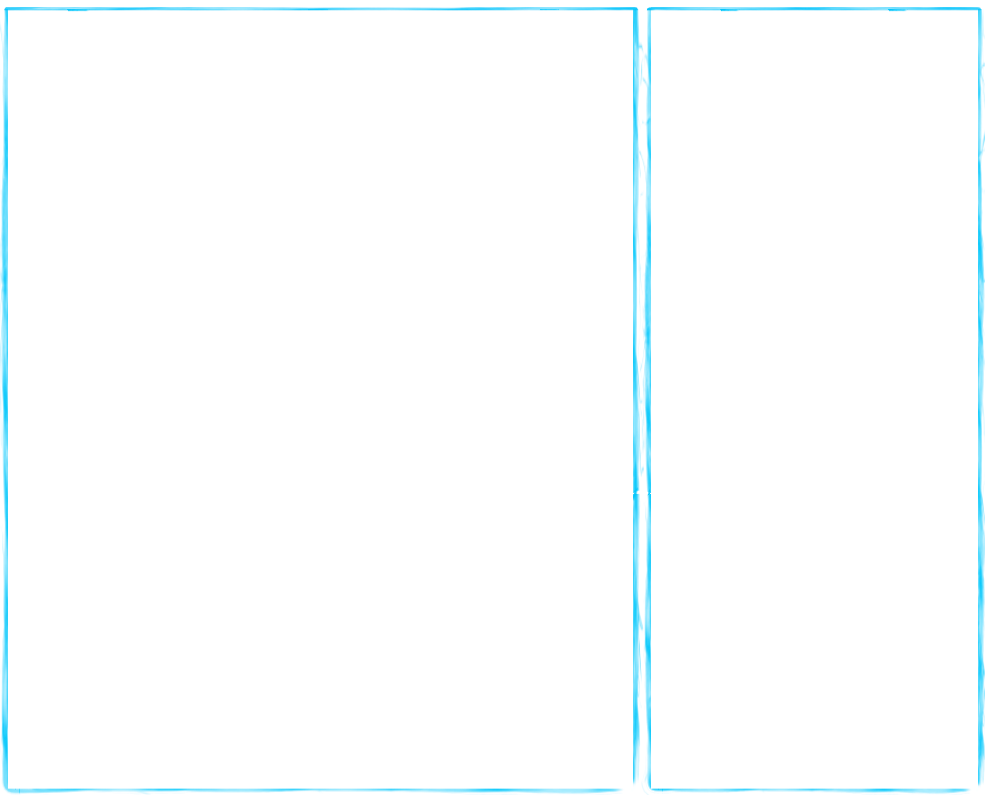

All Science Content
Similar Content
Waves Type
Wave Interference
Wave Parts
Wave Practice
Wave Property Game
Wave Travel Game
Waves Quiz
Waves Video
Vocabulary mouseover for definition
Wave Disturbance causing medium to vibrate.
Medium What a mechanical wave travels through
Vibrate Rapid back and forth motion
Transverse Wave Wave traveling perpendicular to the force
Longitudinal Wave Wave traveling parallel to the force
Surface Wave Also called a combination wave. Wave traveling in a circular motion, between 2 media
Crest Highest part of a transverse wave
Trough Lowest part of a transverse wave
Amplitude (transverse) distance from
resting place to crest/trough
(longitudinal) how compressed or rarefied
Resting Point Represents the medium before a disturbance (represented by a straight line in pictures)
Wavelength (transverse) from crest to crest
OR trough to trough
(longitudinal) from one compression to the next
Compressions The close together parts of a logitudinal wave (bunched up part)
Rarefactions The far apart parts of a logitudinal wave (spread out parts)
Frequency how often a complete wave passes a given point
Hertz unit to measure frequency, or how often a wave passes a given point (cycle per one second)
Reflection A type of wave interference described by a wave bouncing off of its medium.
Refraction A type of wave interference described by a wave bending as it goes through a medium
Diffraction A type of wave interference described by a wave bending around its meduim
Constructive Interference 2 waves interact resulting in a larger amplitude
Destructive Interference 2 waves interact resulting in a smaller amplitude
Similar Content
Waves Type
Wave Interference
Wave Parts
Wave Practice
Wave Property Game
Wave Travel Game
Waves Quiz
Waves Video
Vocabulary mouseover for definition
Wave Disturbance causing medium to vibrate.
Medium What a mechanical wave travels through
Vibrate Rapid back and forth motion
Transverse Wave Wave traveling perpendicular to the force
Longitudinal Wave Wave traveling parallel to the force
Surface Wave Also called a combination wave. Wave traveling in a circular motion, between 2 media
Crest Highest part of a transverse wave
Trough Lowest part of a transverse wave
Amplitude (transverse) distance from
resting place to crest/trough
(longitudinal) how compressed or rarefied
Resting Point Represents the medium before a disturbance (represented by a straight line in pictures)
Wavelength (transverse) from crest to crest
OR trough to trough
(longitudinal) from one compression to the next
Compressions The close together parts of a logitudinal wave (bunched up part)
Rarefactions The far apart parts of a logitudinal wave (spread out parts)
Frequency how often a complete wave passes a given point
Hertz unit to measure frequency, or how often a wave passes a given point (cycle per one second)
Reflection A type of wave interference described by a wave bouncing off of its medium.
Refraction A type of wave interference described by a wave bending as it goes through a medium
Diffraction A type of wave interference described by a wave bending around its meduim
Constructive Interference 2 waves interact resulting in a larger amplitude
Destructive Interference 2 waves interact resulting in a smaller amplitude
CHARACTERISTICS of WAVES
IntroductionHave you ever been standing near radio that was playing music so loud that your ears hurt and the bass was beating in your chest? If you answered “yes” then you have just been a medium for a mechanical wave. Waves are disturbances that cause media to vibrate. They are constantly generated and constantly traveling through different media. Some waves need media (matter) to travel through and some waves can travel through empty space. Waves that need to travel by transferring their energy in matter are called mechanical waves. In simple words, the energy is transferred from one particle to another. No particle, no energy transfer. Waves that do not need matter to travel through are called electromagnetic waves These waves can travel in empty space, or space that has no particles.
Mechanical Waves
There are 3 types of mechanical waves: transverse waves, longitudinal waves, and surface waves.
Transverse Waves
Transverse mechanical waves are waves that travel perpendicular to an applied force. A way to remember that transverse waves travel perpendicular is that "transverse" begins with the letter "T" and "T" forms a perpendicular shape. Below is a picture showing the applied force and wave direction:

You might create a transverse wave by having a friend hold one end of the rope still while you move your end up and down. You are moving the rope in the direction from ceiling to floor, but the wave is traveling away from you towards your friend. That is how the wave travels perpendicular to the force you apply. Radio waves and light waves are transverse electromagnetic waves that do not need a medium to travel through.
For practice on learning the parts of a transverse wave, visit this page
Longitudinal Waves
Longitudinal waves are mechanical waves that travel parallel to an applied force. Below is a picture showing the applied force and wave direction:

You can create a longitudunal wave by having you and a friend hold both ends of a slinky still, while you thump the end. The coils move close together and spread apart as the wave travels toward your friend. That is how the wave travels parallel to the force you apply. Sound waves are an example of a longitudinal wave.
For practice on learning the parts of a longitudinal wave, visit this page
Surface Waves
Surface waves are waves that travel along the boundary between two different media, such as air and water or liquids of different densities. For example, when the medium, wind, blows across the surface of the medium, water, it causes a surface wave to form. They travel in more of a circular motion and not perpendicular or parallel. These waves can be anything from a ripple (centimeters in height) to a massive wave (meters in height). You can see many surfers along the coast enjoying these huge surface waves. However, one of these massive waves can also cause massive damage to or even sink large vessels.
Tsunamis are huge surface waves generated by seismic activity, or landslides. These waves are barely noticeable in the open water, but as they approach a coastline, they arrive in mammoth size. Some even reach 100 feet in height!